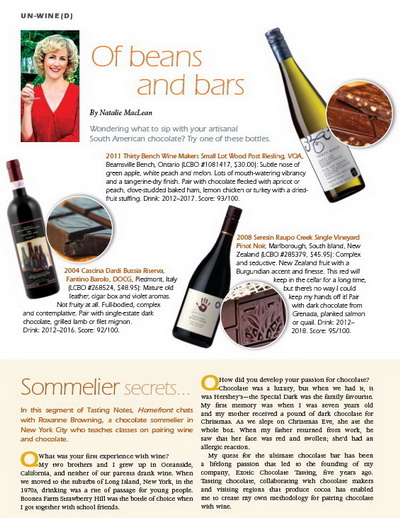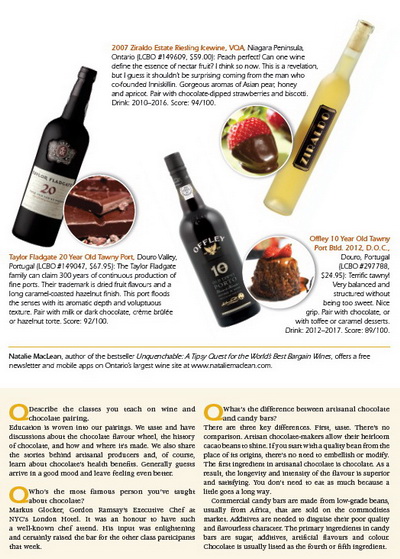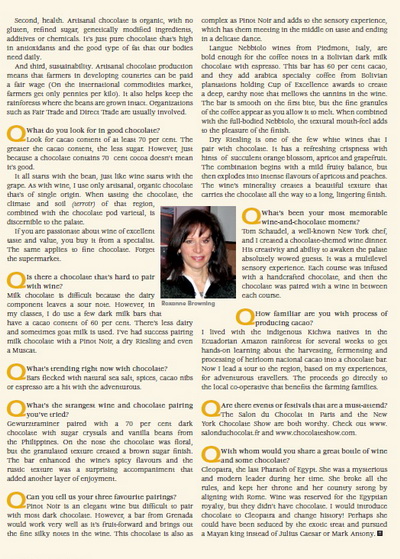 In my recent column for the Ontario interior design magazine Homefront, I featured wine and chocolate pairings, including an interview with chocolate sommelier Roxanne Browning, who teaches classes on pairing wine and chocolate. You can also watch a couple of video interviews with Roxanne on this topic.
In my recent column for the Ontario interior design magazine Homefront, I featured wine and chocolate pairings, including an interview with chocolate sommelier Roxanne Browning, who teaches classes on pairing wine and chocolate. You can also watch a couple of video interviews with Roxanne on this topic.
What was your first experience with wine?
My two brothers and I grew up in Oceanside, California, and neither of our parents drank wine.
When we moved to the suburbs of Long Island, New York in the 1970s, drinking was the right of passage for young people. Cheap wine, Boones Farm Strawberry Hill, was the bottle of choice when I got together with school friends.
Chocolate was a luxury, but when we had it, it was Hershey—the Special Dark was the family favourite. My first memory was when I was seven years old, and my mother received a pound of dark chocolate for Christmas. As we slept on Christmas Eve, she ate the whole box. When my father returned from work, he saw that her face was red and swollen; she had an allergic reaction to it. When I saw my mother on Christmas Day, I thought to myself that chocolate had to be so good because she didn’t share it with us. I made it my mission to taste as much chocolate that came my way. Ever since, it has always lit up my life when I took a bite.
When did you first develop a professional interest in chocolate?
My quest for the ultimate bars has been a lifelong passion that lead to the founding of my company, Exotic Chocolate Tasting, five years ago. Tasting chocolate, comparing types, collaborating with chocolate makers and visiting regions that produce cocoa has enabled me to create my own methodology for pairing chocolate with wine.
Describe the classes you teach on wine and chocolate pairing.
The education is woven into the pairings we taste, with discussions about the chocolate flavour wheel, the history of chocolate, how and where it’s made, the stories behind artisanal producers, and chocolate’s health benefits. Generally guests arrive in a good mood and leave feeling even better.
Who’s the most famous person you’ve taught about chocolate?
Markus Glocker, Gordon Ramsay’s Executive Chef of the London Hotel in NYC. I was honored to have a well-known chef attend: his input was enlightening and raised the bar for the class participants.
What’s the difference between artisanal chocolate and candy bars?
There are three key differences:
Taste: There’s no comparison. Artisan chocolate makers allow their heirloom cacao beans to shine. If you start with a quality bean from the place of its origins, there’s no need to embellish or modify them. The first ingredient in artisanal chocolate is chocolate. As a result, the longevity and intensity of the flavour is superior and satisfying, and you don’t need to eat as much because little goes a long way.
Conversely, commercial candy bars are made from low-grade beans, usually from Africa, sold on the commodities market, and need additives to disguise their poor quality and flavourless character. The first ingredients in candy bars are sugar, additives, artificial flavours and colour. Chocolate usually is listed only as the fourth or fifth ingredient.
Health: Artisanal chocolate is organic, with no gluten, refined sugar, genetically modified ingredients, additives or chemicals. It’s just pure chocolate that’s high in antioxidants and the good type of fat that our bodies need daily.
Sustainability: Artisanal chocolate pays farmers in Third World countries a fair wage and encourages them to continue harvesting cacao, keeping the rain forests intact where the beans are grown. Organizations such as Fair Trade and Direct Trade are usually involved, whereas on the international commodities market farmers only get pennies per kilo for their beans.
How does this type of chocolate influence the wine pairings?
I use only artisan, organic chocolate that’s of single origin like wine. When tasting the chocolate, the climate and soil (terrior) of that region, combined with the chocolate pod varietal, is discernible to the palate.
What are your tips for buying good chocolate?
Look for bars that have cacao content of at least 70 to 75 percent. The greater the cacao content, the less sugar the bar contains. However, just because a chocolate contains 70 percent cocoa doesn’t mean it’s good. It all starts with the bean, just like wine starts with the grape. Don’t expect to find quality chocolate in a supermarket. If you are as passionate about finding wine of excellent taste and value, you buy it from a specialist, and the same applies to fine chocolate.
What are some of your tips for pairing wine and chocolate?
Look for a balance of flavours; one should not overpower the other. In the long finish (after taste), is where you will find the successful match.
What’s the toughest chocolate to pair with wine?
Milk chocolate is difficult because the dairy component leaves a sour note. However, in my classes, I do use a few dark milk bars that have cacao content of 60 percent. Therefore, there’s less dairy and sometimes goat milk is used. I’ve had success pairing it with a pinot noir, a dry riesling and a moscato.
What’s popular right now for types of chocolate?
Bars flecked with natural sea salt, spices, cacao nibs or espresso are popular for the adventurous.
What’s the strangest wine and chocolate pairing you’ve tried?
Gewurztraminer paired with a 70 percent dark chocolate with sugar crystals and vanilla beans from the Philippines. On the nose the chocolate was floral, but the texture was rustic and the granulated texture created a brown sugar finish. The bar enhanced the wine’s spicy flavours and the rustic texture was a surprising accompaniment that added another layer of enjoyment.
Name your three favorite wine and chocolate pairings.
Pinot noir is an elegant, but difficult wine to pair with most dark chocolate. However, a bar from Grenada would work very well as it’s fruit-forward and brings out the fine silky notes in the wine. This chocolate is also as complex as pinot noir and adds to the sensory experience since they meet in the middle taste and end in a delicate dance afterwards.
Langue Nebbiolo wines from Piedmont, Italy, are bold enough for the coffee notes in Bolivian dark milk chocolate with espresso. This bar has 60 percent cacao and they add Arabica specialty coffee from Cup of Excellence-awarded plantations in Bolivia to create a deep, earthy note that mellows the tannins in the wine. The texture of the bar is smooth on the first bite, but as you allow it to melt, the fine granulated texture of the coffee appears. When combined with the full-bodied Nebbiolo, the textural mouth-feel adds to the pleasure in the finish.
Dry riesling is one of the few white wines that I pair with chocolate. It has a refreshing crispness with hints of succulent orange blossom, apricot and grapefruit. The combination begins with a mild fruity balance, but then explodes into intense flavours of apricot and peaches in both the wine and the chocolate. The wine’s minerality creates a beautiful texture that carries the chocolate all the way to the long, lingering finish.
What’s been your most memorable moment wine-and-chocolate wise?
Tom Schaudel, a well-known New York chef, and I created a chocolate-themed wine dinner at one of his restaurants. His creativity and ability to awaken the palate with each course wowed our guests. It was a multi-level, sensory experience, each course was infused with a handcrafted chocolate, and then in between each course, the chocolate was paired with the wine. It allowed the guests to distinguish the chocolate when paired with wine on its own as well as its subtlety when part of a dish.
To which chocolate-producing region have you travelled recently?
I lived with the indigenous Kichwa natives in the Ecuadorian Amazon rain forest for several weeks to get hands-on learning about the harvesting, fermenting and processing of heirloom nacional cacao into a chocolate bar. Now I lead a tour to the region, based on my experience, for adventurous travelers, and the proceeds go directly to the local co-operative that benefits the farming families.
Are there any special chocolate-related events or festivals that you like to attend?
The Salon du Chocolat in Paris and the New York Chocolate Show are both worth attending. You can find more information at www.salonduchocolat.fr and www.chocolateshow.com.
With whom would you share a great bottle of wine and some chocolate?
Queen Cleopatra, the last Pharaoh of Egypt, who reigned from 51 to 30 BCE. She was a mysterious and modern leader during her time who broke all the rules, kept her throne and her country strong by aligning with Rome. Wine was reserved for Egyptian royalty, but they didn’t have chocolate. I would have loved to introduce chocolate to Cleopatra and change history! She might have been seduced by the exotic treat and pursued an Aztec king instead of Caesar or Mark Antony.
Roxanne Browning, Chocolate Sommelier: www.exoticchocolatetasting.com
More interviews with sommeliers.










